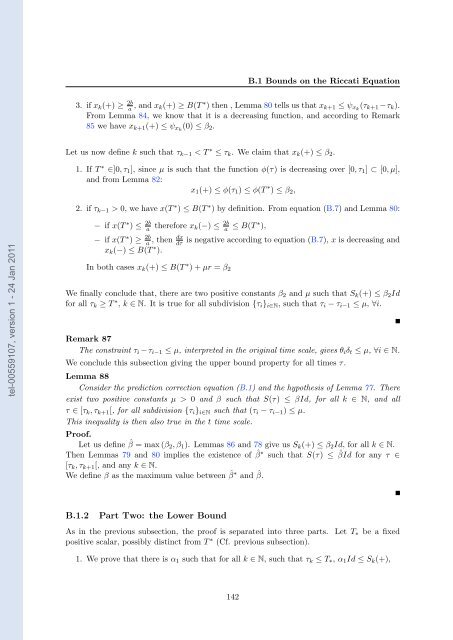Adaptative high-gain extended Kalman filter and applications
Adaptative high-gain extended Kalman filter and applications
Adaptative high-gain extended Kalman filter and applications
Create successful ePaper yourself
Turn your PDF publications into a flip-book with our unique Google optimized e-Paper software.
tel-00559107, version 1 - 24 Jan 2011<br />
B.1 Bounds on the Riccati Equation<br />
3. if xk(+) ≥ 2b<br />
a , <strong>and</strong> xk(+) ≥ B(T ∗ ) then , Lemma 80 tells us that xk+1 ≤ ψxk (τk+1 −τk).<br />
From Lemma 84, we know that it is a decreasing function, <strong>and</strong> according to Remark<br />
85 we have xk+1(+) ≤ ψxk (0) ≤ β2.<br />
Let us now define k such that τk−1 0, we have x(T ∗ ) ≤ B(T ∗ ) by definition. From equation (B.7) <strong>and</strong> Lemma 80:<br />
− if x(T ∗ ) ≤ 2b<br />
a therefore xk(−) ≤ 2b<br />
a ≤ B(T ∗ ),<br />
− if x(T ∗ ) ≥ 2b dx<br />
a , then dτ is negative according to equation (B.7), x is decreasing <strong>and</strong><br />
xk(−) ≤ B(T ∗ ).<br />
In both cases xk(+) ≤ B(T ∗ )+µr = β2<br />
We finally conclude that, there are two positive constants β2 <strong>and</strong> µ such that Sk(+) ≤ β2Id<br />
for all τk ≥ T ∗ , k ∈ N. It is true for all subdivision {τi}i∈N, such that τi − τi−1 ≤ µ, ∀i.<br />
Remark 87<br />
The constraint τi − τi−1 ≤ µ, interpreted in the original time scale, gives θiδt ≤ µ, ∀i ∈ N.<br />
We conclude this subsection giving the upper bound property for all times τ.<br />
Lemma 88<br />
Consider the prediction correction equation (B.1) <strong>and</strong> the hypothesis of Lemma 77. There<br />
exist two positive constants µ > 0 <strong>and</strong> β such that S(τ) ≤ βId, for all k ∈ N, <strong>and</strong> all<br />
τ ∈ [τk, τk+1[, for all subdivision {τi}i∈N such that (τi − τi−1) ≤ µ.<br />
This inequality is then also true in the t time scale.<br />
Proof.<br />
Let us define ˆ β = max (β2, β1). Lemmas 86 <strong>and</strong> 78 give us Sk(+) ≤ β2Id, for all k ∈ N.<br />
Then Lemmas 79 <strong>and</strong> 80 implies the existence of ˆ β ∗ such that S(τ) ≤ ˆ βId for any τ ∈<br />
[τk, τk+1[, <strong>and</strong> any k ∈ N.<br />
We define β as the maximum value between ˆ β ∗ <strong>and</strong> ˆ β.<br />
B.1.2 Part Two: the Lower Bound<br />
As in the previous subsection, the proof is separated into three parts. Let T∗ be a fixed<br />
positive scalar, possibly distinct from T ∗ (Cf. previous subsection).<br />
1. We prove that there is α1 such that for all k ∈ N, such that τk ≤ T∗, α1Id ≤ Sk(+),<br />
142

















